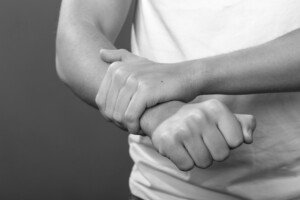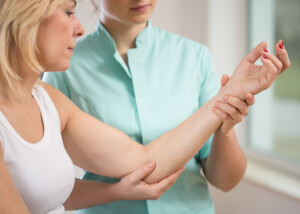
Just how painful can pronator teres syndrome be?
This condition is much under-publicized, and its symptoms can mimic carpal tunnel syndrome (CTS).
Any condition that involves a nerve can cause pain.
Pronator teres syndrome involves pressure on the same nerve that’s involved with CTS: the median nerve, a major nerve running down the arm.
“There are varying degrees of pain and paresthesias with pronator syndrome,” says Jonathan Oheb, MD, North Valley Orthopedic Institute, Chief of Orthopedic Hand and Upper Extremity Surgery.
And what is a paresthesia?
Paresthesia is a sensation of tingling, numbness, burning or prickling on the skin, often described as “pins and needles.”
It commonly occurs in the hands, arms, legs or feet and can be temporary from pressure on nerves, or chronic due to underlying conditions like nerve damage or circulatory issues.
Dr. Oheb continues, “With pain localized over the proximal forearm and paresthesias distally in the thumb, index, middle and half of the ring finger.”
Those finger locations are the same as with carpal tunnel syndrome. This is why sometimes initially, the physician will suspect CTS first.
The reason that the pain or discomfort of either pronator or carpal tunnel syndrome does not affect the entire ring finger or any part of the pinky is due to the distribution of the nerves branching out.
The branching distribution does not reach the muscles and nerves in those areas; thus, they are not part of the pain with these neuromuscular conditions.
Pronator syndrome is less common than CTS, but it can definitely cause pain.
CTS affects about 3-6% of adults, while pronator syndrome is relatively rare, though exact prevalence is unknown.
Estimates suggest pronator syndrome occurs at a rate 10 to 100 times less frequently than does carpal tunnel syndrome due to anatomical differences in nerve compression sites and more prominent symptoms.
“Pronator syndrome usually presents with pain localized in the proximal forearm which is made worse with repetitive prono-supination of the forearm,” says Dr. Oheb.
The pain can be bad enough to prevent strength training or household duties that activates that region.
The proximal area refers to that closer to the center of the body.
In this case it would mean near the elbow and inner portion of the forearm if you were standing with your arm hanging straight at your side.
Prono-supination refers to rotating the forearm from that of a palm-down position to a palm-up position.
 In addition to hand, elbow and shoulder care, Dr. Oheb provides comprehensive surgical and nonsurgical treatment for all orthopedic conditions of the hip, knee and ankle, including broken bones and injuries. jonathanohebmd.com
In addition to hand, elbow and shoulder care, Dr. Oheb provides comprehensive surgical and nonsurgical treatment for all orthopedic conditions of the hip, knee and ankle, including broken bones and injuries. jonathanohebmd.com
 Lorra Garrick is a former personal trainer certified through the American Council on Exercise. At Bally Total Fitness she trained women and men of all ages for fat loss, muscle building, fitness and improved health.
Lorra Garrick is a former personal trainer certified through the American Council on Exercise. At Bally Total Fitness she trained women and men of all ages for fat loss, muscle building, fitness and improved health.
.
Top image: Shutterstock/Kristiana Gankevych








































